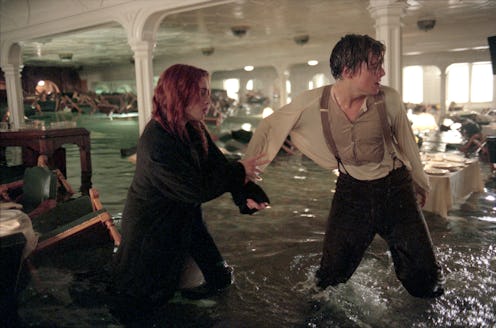Life
9 Creepy Facts You Didn't Know About The Titanic

Most of the details of the sinking of the Titanic are well-known. At 11:40 p.m. on April 14, 1912, the RMS Titanic struck an iceberg in the North Atlantic Ocean. Over the next two hours and 40 minutes, the ship filled with water and sank, killing more than 1,500 people, including a fictional young man whose girlfriend wouldn't make room for him on the door on which she was floating, even though there was clearly plenty of room. But the story of the Titanic is made up of so many more creepy facts that often get forgotten.
Here's some background in case, unlike me, you don't regularly watch the first half of Titanic and then stop and pretend everything works out. When the ship set off on her maiden voyage on April 10, departing from Southampton on the first leg of her journey to New York, she was the largest ship in the world, measuring 882 feet in length, and the largest man-made moving object on Earth. Her lavish facilities included a gym, pool, Turkish bath, and a kennel for first-class pups. There were 2,224 people on board, including poor emigrants from Armenia, Ireland, Italy, Sweden, Syria, and Russia, hoping to make a life for themselves in the United States, as well as some of the richest people in the world, like John Jacob Astor and Benjamin Guggenheim.
Four days after leaving from Southampton, the ship hit an iceberg while traveling through an area known as "Iceberg Alley." The collision tore an enormous gash through the hull, and the ship filled with water. While luxurious, the ship was ill-equipped to deal with such a disaster (they only had enough lifeboats for a third of the ship's total capacity). Only 705 of the over 2,000 people onboard survived.
While these basic numbers are stunning, as is often the case, the most striking details are found in the smaller stories, the tales of individuals who experienced one of the greatest maritime disasters in human history. Here are some of the most chilling facts about that tragic night, 105 years ago:
Check out the entire 'What's Up, Boo?' series and other videos on Facebook and the Bustle app across Apple TV, Roku, and Amazon Fire TV.
An American Author "Predicted" The Sinking Of The Titanic
In 1898, American author Morgan Robertson wrote The Wreck of the Titan: Or, Futility, a novella about an enormous ocean liner called the Titan which hits an iceberg in the North Atlantic and sinks. And like the Titanic, the Titan has far too few lifeboats onboard, which leads to mass casualties.
Later, Robertson would be called a clairvoyant, which he rejected.
A Full Moon May Have Caused The Tragedy
Scientists now believe that a full moon unusually close to Earth may have contributed to the sinking of the great ship. As National Geographic's Richard A. Lovett wrote: "That full moon, on January 4, 1912, may have created unusually strong tides that sent a flotilla of icebergs southward — just in time for Titanic's maiden voyage." He added that it was the closest lunar approach since the year 796.
An Optical Illusion Seems To Have Been At Play As Well
The atmosphere on the night of the sinking may have made it difficult for the crew to spot the iceberg, and for other ships to spot the Titanic. According to Smithsonian magazine:
Atmospheric conditions in the area that night were ripe for super refraction, Maltin found. This extraordinary bending of light causes miraging, which, he discovered, was recorded by several ships in the area. He says it also prevented the Titanic’s lookouts from seeing the iceberg in time and the freighter Californian from identifying the ocean liner and communicating with it.
A Lifeboat Drill Was Scheduled For The Same Day The Ship Sank, But Canceled For Unknown Reasons
The drill could have helped passengers and crew be better-prepared.
Musicians Really Did Continue To Play As The Ship Sank
There were two bands onboard the ship that played for over two hours as the ship sank. All of them perished.
Most Of The Victims Died Of Hypothermia...
When the ship sank, the temperature in the water was around 28 degrees Fahrenheit, below freezing. Few would have survived more than 15 minutes in such frigid temperatures, and approximately one in five would have died within two minutes.
... But One Man Claimed To Have Survived The Cold Waters Thanks To Whiskey
Charles Joughin, the ship's baker, survived in the icy water for two hours before he was rescued. He claimed he didn't feel cold because of all the whiskey he had drunk on the ship.
A Ship Nearby Could Have Saved Them
Just 20 miles away, the SS Californian had stopped to avoid the ice. Its captain saw the Titanic's flares, but ignored them because he thought they were "company rockets." The Titanic's SOS signals were not received until the next morning, because the Californian's radio operator had gone to sleep. By the time they got to the scene the next day, all they found were bodies.
The First Newspaper To Report The Sinking Said There Were No Casualties
On Tuesday, April 16, the day after the Titanic sank, the U.K.'s Daily Mail reported that the ship collided with an iceberg, but no lives were lost. It wasn't long before they realized what a terrible mistake they had made.